Harvesting onions is easy, but it can be difficult for newbies to know when they are ready. So in this post, I will tell you how to figure out when to pick onions for the biggest and best crop, and show you exactly how to do it.
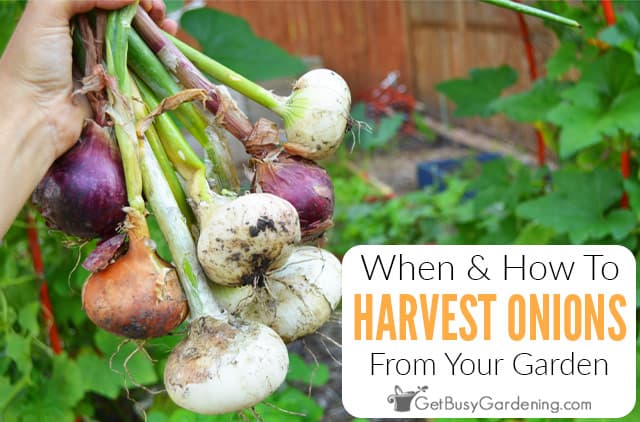
One of the great things about harvesting onions is that it’s really hard to get it wrong. Unlike so many other vegetables, they’re a patient crop that you can take your time with.
But of course, there are some important things to keep in mind so that you’ll have the best and healthiest crop. And, when you do it right, you will be able to store for the long term.
In this detailed guide, you’ll learn everything you need to know about onion harvesting. Including how to determine when they are ready, how to properly pick them, and tips for storing them.
How To Know When Onions Are Ready To Harvest
Onions are edible at any point, no matter how small they are. You don’t have to wait until they are “ripe” to pick them.
So, if you need one for a recipe, simply pluck it out of the garden whenever you want.
Though you can pull them at any point, there is an ideal time to harvest onions. Especially if you want them to get as large as possible.
It’s easy to tell when they’re ready. The stem will turn brown, and usually fall over. When this happens, it means that they’re ready to be pulled.
Related Post: How To Grow Onions At Home
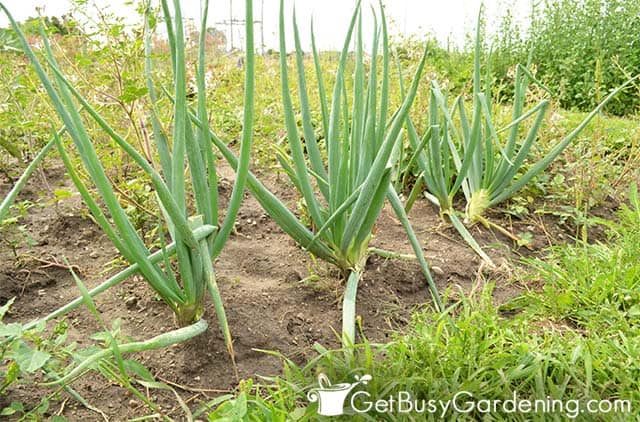
When To Harvest Onions
The best time to pick onions is right after the stem turns brown and falls over.
However, one of the great things about them is that you don’t need to pull them right away. You can leave them in the garden until YOU are ready.
That really helps take the stress out of harvesting, because so many other vegetables need to be picked as soon as they’re ready, or they could go bad.
As long as your garden stays fairly dry anyway. If you get a lot of rain, or the soil is really wet, then you shouldn’t wait too long to pluck your onions, or they could rot.
Don’t worry, they are pretty hardy, and won’t be bothered by frost. So you have plenty of time to get them all pulled before the cold fall weather comes.
Related Post: How To Make Onion Jam (Recipe & Instructions)

Can You Harvest Onions After They Flower?
Sometimes onions will start to flower before the stem turns brown. If this happens, then pull that one and use it right away because they won’t store well.
You should not let them flower because that will steal all the energy from the bulb, making it super small. Which means there won’t be much left for you to eat.
How To Harvest Onions
Harvesting onions is as easy as just pulling them out of the ground. Inspect each one for damage, and gently squeeze it to make sure it’s firm.
If any of them are damaged or are showing signs of rot, then you’ll definitely want to use those up first, rather than trying to store them.
Also, be gentle when handling freshly picked onions. Don’t toss them into a pile, or haphazardly drop them into a bucket.
Mishandeling them like that could end up bruising them, which usually causes them to rot in storage much faster.
Related Post: The Best Pickled White Onions Recipe
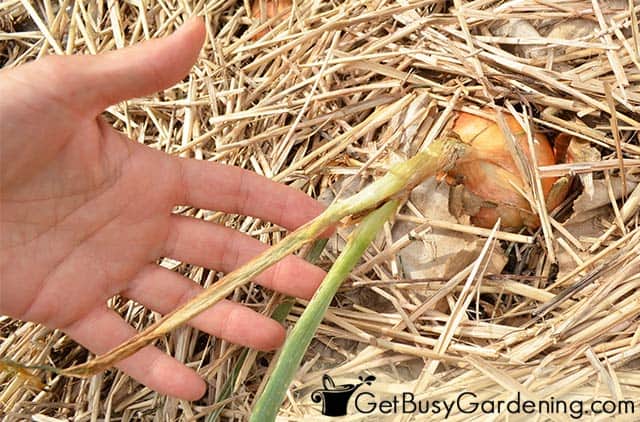
How Often Can You Pick Onions?
You can pick onions as often as you’d like. As I mentioned above, they are edible at any stage, so you don’t have to wait for the stems to fall over.
Otherwise, just pick them as the stems turn brown, and leave the rest in the garden to get larger. The longer you can leave them, the bigger they will get.
Related Post: How To Grow Onions From Seed & When To Start
What To Do With Onions After You Pick Them
Onions need to be cured (dried) for several days before you store them, or they could rot or mold.
If it’s dry enough, you can simply pop them out of the ground, and let them sit there for a day or two until you’re ready to collect them.
Then move them into a garage or dry basement for several days or weeks to allow them to cure. When properly cured and stored, onions can last for six months to a year.
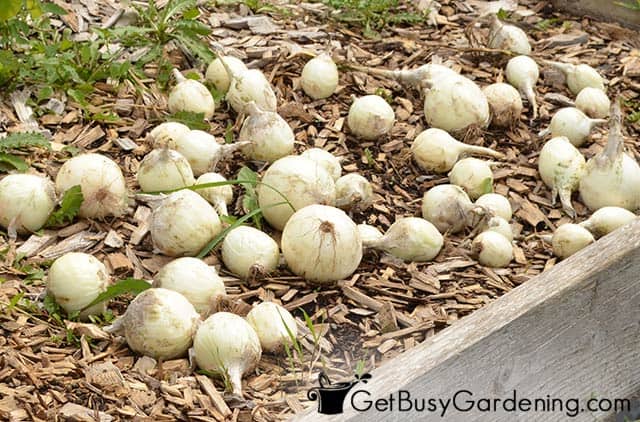
Tips For Curing Onions After Harvesting
To cure them after harvesting, you can bring your onions indoors. Then lay them out on cardboard or a shelf, spacing them so they aren’t touching each other.
If there’s no rain in the forecast, you can dry them in the sun, which will help speed up the process.
You’ll know they are cured when the stem is completely dry, the skins are tight, and there’s no moisture left on top of the bulb.
Related Post: How To Can Onions
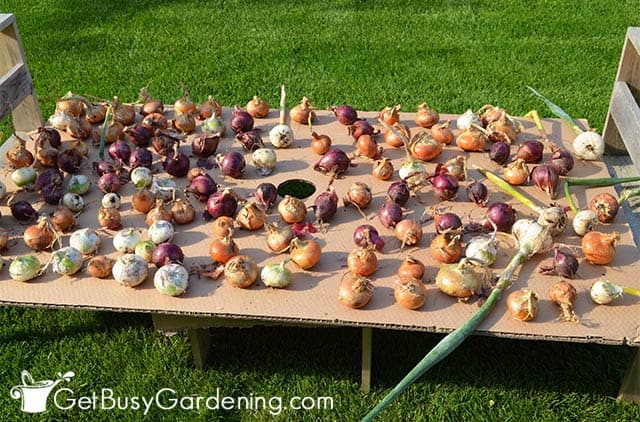
Tips For Storing Onions After Harvesting
Once cured, you can trim off the stems and roots, and put them into a wooden crate, box, or storage rack. Then keep them in a cool, dry, and dark location, like a pantry or cellar, for winter.
Check on them regularly for signs of rot or sprouting, and be sure to use those up first. They can last for several months when dried properly. Mine usually last until just before the following harvesting season.
Related Post: Free Garden Harvest Tracking Sheet & Guide
FAQs About Harvesting Onions
Now that we’ve gone over everything about digging up your bounty, you might still have a few questions. Here are some of the most common ones about onion harvesting.
Can you eat onions straight from the garden?
Yes, you can eat onions straight from the garden. And you definitely should for any that are pulled before the stem browns and bends. But sometimes freshly harvested onions don’t have as many dry layers on the outside, so you might need to rinse them to remove dirt instead of peeling them.
How long can you leave onions in the ground?
You can leave onions in the ground for several days before pulling them, as long as it is dry. That’s one of their best advantages! However, if it’s wet or raining a lot, then they should not stay in the ground for very long, as they are more likely to rot.
What happens if you don’t harvest onions?
If you don’t harvest onions, they may eventually start rotting, especially if the soil is very wet, or they will flower. But sometimes they’ll sprout again after a period of dormancy. Dry ground is more likely to preserve the bulb until spring.
Do you harvest onions before they flower?
Yes, you should definitely harvest onions before they flower. Otherwise, the bloom will steal nutrients from the bulb, leaving it small and tough, and eventually it will be completely inedible.
Do you need to dry onions after harvesting?
You need to dry onions after harvesting if you want to store them for the long term. Otherwise, if you plan to eat them right away, there’s no need to dry them first.
How many onions do you get from one plant?
You will only get one full-sized onion per plant. But sometimes you can sprout the bottom after cutting it, which will yield some yummy greens.
Now you’re an expert in harvesting onions! Plus you know exactly how to handle them for immediate use, or prepare them for long-term storage. Knowing when to pull onions will ensure you will have the largest, healthiest crop possible.
More Posts About Harvesting
- When & How To Harvest Potatoes
- How To Harvest Chives & When To Pick Them
- Harvesting Kohlrabi – Everything You Need To Know
- When & How To Harvest Tomatillos
- Harvesting Brussels Sprouts – Everything You Need To Know
Share your tips for harvesting onions in the comments below.
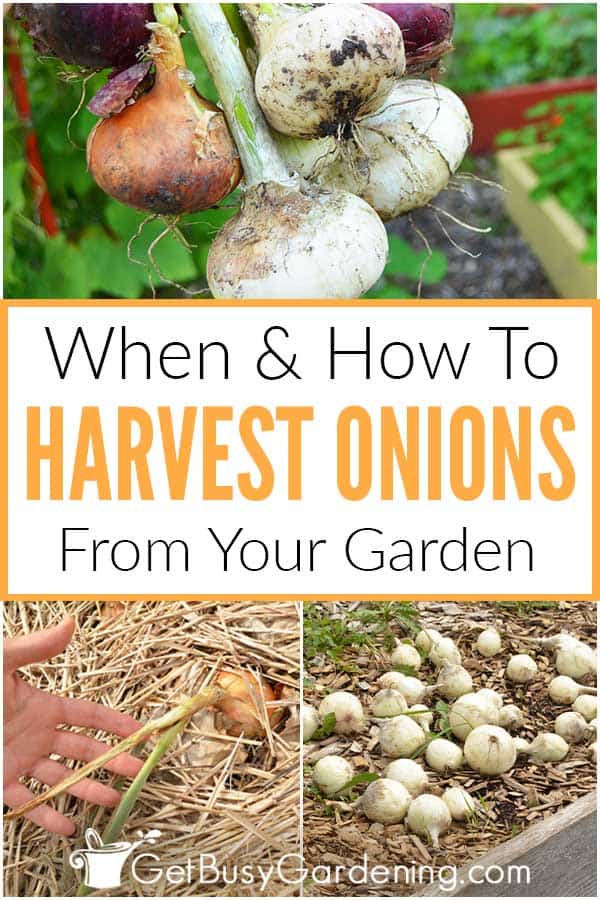
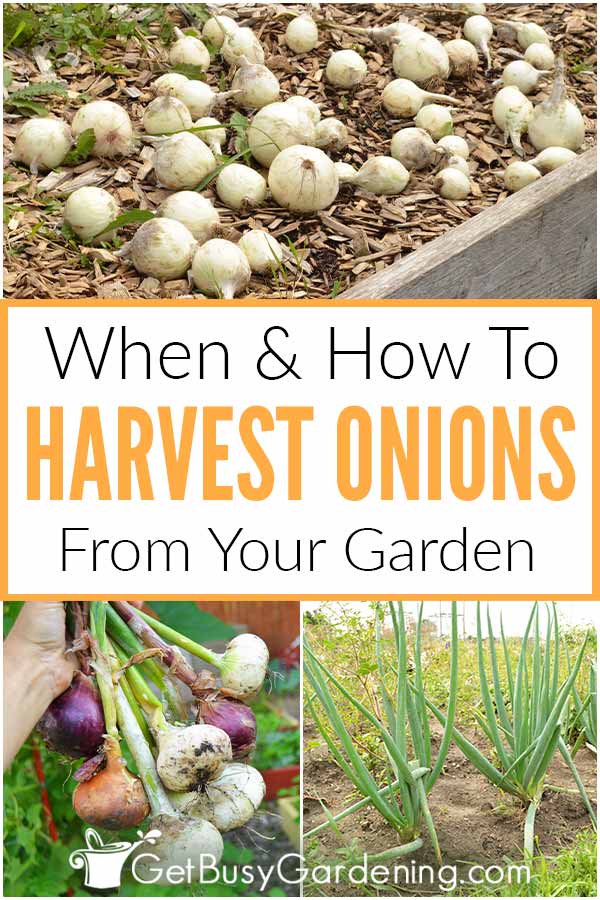



norman levine says
I grew Duke of York potatoes under barley straw last year and got a great crop of nice egg sized potatoes. I live near stud farms and get horse manure every. It produces great crop and I have a wonderful yield of onions this year and garlic.
Helen Wood says
What if you get a flower? Do you cut it off & let the onion keep growing, or is it too late & you need to take it right out? Also, what do you do to “keep them from flowering?” Mine are just flowing away on green stems. I have not gotten to the brown-stemmed, time-to-harvest stage yet!
Amy Andrychowicz says
You should harvest all of the onions as soon as they start to set flowers. If you let them bloom, they’ll steal energy away from the bulb, and it will become inedible. If it’s too late, and the flowers have already gotten tall, then you could let them set seed, then collect and save them for next year. So no waste! 🙂 Bees love the flowers too.
Heidi says
When I’m ready to pick my onions do I cut any of the stem off if there fairly long?
Amy Andrychowicz says
It’s best to leave the stems on your onions after you harvest them. Wait until they’re cured and the stems are completely dried out before cutting them off.
Kathryn says
Should I water my potato plants everyday and should I keep putting soil around them as they grow?
Amy Andrychowicz says
How often you water depends on your soil composition and climate, and yes, you should keep putting soil around the vines so they produce more. Here’s an article with all the details about how to grow potatoes.
Lloyd says
Last winter I covered my carrots and parsnips with foot and a half of mulched leaves. I was able to harvest them right until the end of February. Could I do the same thing with onions?
Amy Andrychowicz says
You could certainly try it! I’ve had onions survive the winter in my Minnesota garden under a thick layer of straw (accidentally!). It’s always fun to experiment.
Erlene A says
This was the first year I grew onions in my garden and while mine didn’t grow as large as yours, I was still able to get a few good ones to use. I’ll definitely be trying again next year.
Amy Andrychowicz says
Glad to hear you were still able to harvest a few onions from your garden. Hope they’ll do better for you next year.
Ron Mitchell says
I got my onion and shallot sets in a bit late and as a result some grew nicely and others no so nicely. But all in all they were worth planting. Onions are something you cook with almost every day and next year I intend to expand my plantings of them.
Amy Andrychowicz says
That’s exactly why we started growing them too!